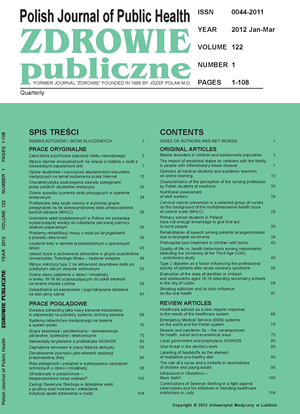Primary school students in Poland have not enough knowledge to give first aid to burnt people
Keywords:
burns, health education, first aidAbstract
Introduction. The opportunities to improve prevention and early detection of cervical cancer and improvement of the treatment outcomes are closely related to knowledge, attitudes and women’s behavior. Nurses and midwives due to the specificity of their work have a significant role in the prevention and early detection of female cancers.
Aim. Evaluation of prevention cervical cancer in a group of nurses on the background of the Multidimensional Health Locus of Control Scale (MHLC).
Material and methods. The study was carried out in September 2008 among 100 randomly selected nurses working in hospitals all around Cracow. The study used the method of diagnostic survey, tools included: a questionnaire and MHLC Scale).
Results. One third of the nurses acknowledged that they had annually gynecological checkup, 15% every six months and more often, and as many as 15% of women did not remember the last time they were at the gynecologist. Pap smear was performed every year by 31% of respondents, every two years by 18% of women, and once every three years by 11%. Nearly one third of nurses had a smear test done more than three years ago, and 12% did not remember the last time it was made. The average value of the internal health locus on the scale of MHLC was 25.60, indicating that the respondents were convinced that the control over their own health depends on themselves.
Conclusions. Nurses’ health behavior reduced the risk of developing cervical cancer, but did not promote its early detection by avoiding the regular gynecological checkups and Pap tests. Nurses were convinced more often that their own health was in their hands but however, did not show this type of behavior in the preventive actions.
References
1. Alson RL, Tread RC. Oparzenia. In: Basic Trauma Life Support dla paramedyków i ratowników medycznych. Kraków: Wydanie Polskie Medycyna Praktyczna; 2006. p. 207-25.
2. Cline DM, Ma OJ, Tintinalli JE. Medycyna ratunkowa (1st Polish edition; ed. Juliusz Jakubaszko). Wrocław: Urban & Partner; 2003.
3. Dudak K. Czy uczyć pierwszej pomocy w szkole podstawowej?, Edukacja dla Bezpieczeństwa. 2001;3(4):61-4.
4. Strużyna J. Wczesne leczenie oparzeń. Warszawa: PZWL; 2006.
5. Żuratyński P, Brudny J, Łukomska A, Ślęzak D, Szrajda J. Analiza przypadków oparzeń na podstawie danych ze Szpitalnego Oddziału Ratunkowego Wojewódzkiego Centrum Medycznego w Opolu w roku 2004. In: Medycyna Ratunkowa w Polsce: zima 2009. Wrocław: Polskie Towarzystwo Medycyny Ratunkowej; 2009. p.139-59.
6. Czajkowska K. Stany zagrożenia zdrowia i życia spowodowane oparzeniami. Bachellor thesis, Bydgoszcz: Collegium Medicum im. Ludwika Rydygiera; 2005.
7. Fibak J. Chirurgia. Warszawa: PZWL; 2005.
8. Stebelski M. Pierwsza pomoc w szkole. Kierowanie szkołą. 2007;3(103). 9. Ustawa z dnia 8 września 2006 roku o Państwowym Ratownictwie Medycznym (Dz.U.nr. 191 z 20 Października 2006 , pos. 1410).
10. Sobków R. Jak realizowany jest w mojej szkole program udzielania pierwszej pomocy przedlekarskiej? Edukacja dla Bezpieczeństwa. 2002;3:33-4.
11. Jasińska D. Program profilaktyki i zapobiegania skutkom oparzeń w klasach IV–VI szkoły podstawowej. Lublin; 2001, www.interklasa.pl (on-line: 01-06-2010).
12. Pękała T. „Żyj bezpiecznie” Program profilaktyki i zapobiegania skutkom oparzeń dla klas I-VI szkoły podstawowej. Edukacja dla Bezpieczeństwa. 2001;2:49-50.
13. Kubiak K. Pierwsza pomoc – wspólna sprawa. Na Ratunek. 2009;2(10):26–2.
14. Kalina RM, Kałużny R, Kądziołka W. Gotowość niesienia pomocy innym przez różne grupy społeczne. Wychowanie Fizyczne i Zdrowotne. 2000;2/3:89-94.
15. Paciorek P, Cichańska M, Branicka T, Pawlikowska-Cichy J. Kształcenie w zakresie udzielania pierwszej pomocy przez studentów Ratownictwa Medycznego. Analiza doświadczeń. In: Koniecznego J, Sroki K, ed. Jarocin Samorząd terytorialny – od społeczeństwa ryzyka do społeczeństwa bezpieczeństwa. Poznań, Szczecin: ARP Promocja 21; 2006. p. 244-53.


